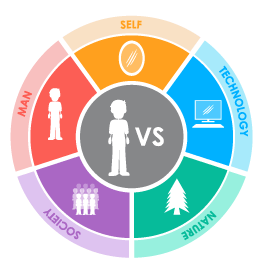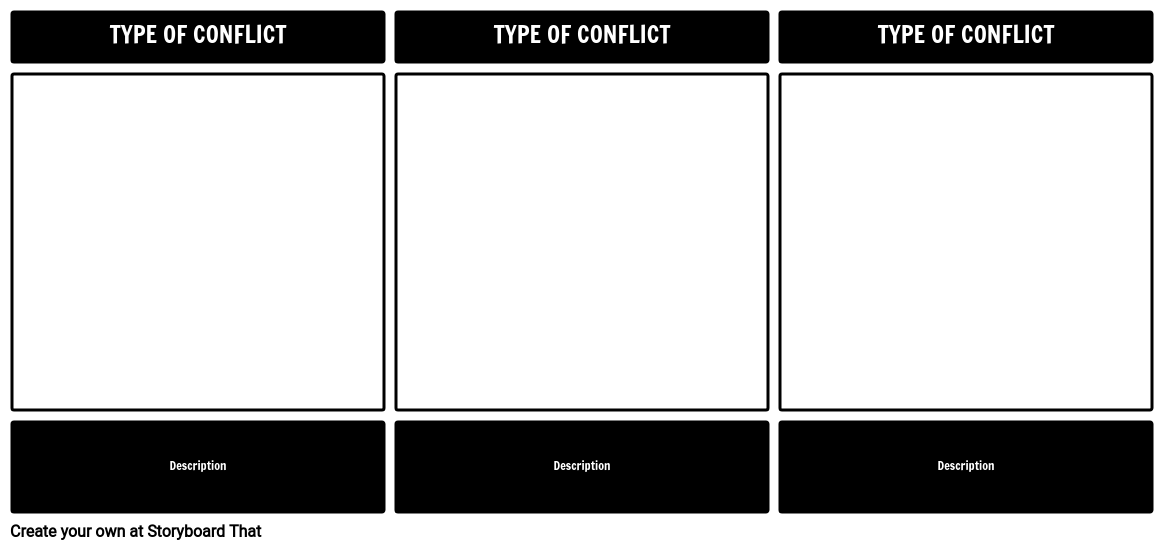Lesson Plan Overview
Storyboarding is an excellent way to focus on types of literary conflicts.
Having students create storyboards that show the cause and effect of different types of conflicts strengthens analytical thinking about literary concepts. Have your students choose an example of each literary conflict and depict them using the storyboard creator. In the storyboard, an example of each conflict should be visually represented, along with an explanation of the scene, and how it fits the particular category of conflict.
Examples of Literary Conflict in “Hills Like White Elephants”
MAN vs. SELF
Jig seems unsure of what she should do. She knows that no matter what choice she makes, her relationship with the American man can never go back to the way it was. She also seems to have to talk herself into accepting that she will do the procedure, rather than making the choice willingly.
MAN vs. MAN
Jig and the American man are at odds with one another. He wants her to have the operation, but she is not as willing to do so. He wants them to be together and travel as they have been doing, but she knows that it is much more complicated than that no matter what decision she makes. Ultimately, she just wants him to stop talking, and he walks away, hoping to clear some of the tension between them.
MAN vs. SOCIETY
What the American man and Jig are discussing doing is at odds with society, especially in the 1920s, where abortion was illegal in many countries and in the United States. While they know others who have gone through with it and seem to be happy with their decision, it is still a risk, and it is still a major decision that is frowned upon by many.
Template and Class Instructions
(These instructions are completely customizable. After clicking "Copy Activity", update the instructions on the Edit Tab of the assignment.)
Student Instructions
Create a storyboard that shows at least three forms of literary conflict in “Hills Like White Elephants”.
- Identify conflicts in “Hills Like White Elephants”.
- Categorize each conflict as Character vs. Character, Character vs. Self, Character vs. Society, Character vs. Nature, or Character vs. Technology.
- Illustrate conflicts in the cells, using characters from the story.
- Write a short description of the conflict below the cell.
Lesson Plan Reference
Student Rubric
(You can also create your own on Quick Rubric.)
| Proficient | Emerging | Beginning | Try Again | |
|---|---|---|---|---|
| Conflict Identification | Student identifies correct major conflicts and uses strong, clear textual evidence to support choice. | Student identifies correct major conflict and uses few or unclear details to support their choice. | Student identifies incorrect major conflict, and uses some details from the text to support their choice. | Student does not attempt to identify major conflict or identifies incorrect major conflict with no explanation. |
| Understanding Outcome | Student clearly shows the outcome of the conflict and its effects on the protagonist with evidence from the text. | Student shows the outcome of the conflict and its effect on the protagonist, but some evidence is unclear. | Student shows the outcome of the conflict, but does not examine its effect on the protagonist and uses some vague textual evidence. | Student does not clearly show the outcome of the conflict or use textual evidence. |
| Character | Storyboard includes all required characters and clearly names them. Goes above and beyond by adding additional details. | Storyboard includes all required characters and clearly names them. | Storyboard includes protagonist and antagonist but leaves out other required characters. | Storyboard does not include the names of required characters. |
| Storyboard | Student clearly shows effort to convey the setting the scene of the book | Student attempts to convey setting and scene of the book, but lacks some clarity. | Student does not clearly convey the setting and scene. | Student makes little or no attempt to convey the setting or scene. |
| Spelling and Grammar | Student uses exemplary spelling and grammar. There are no errors. | Student makes a minor error in spelling and grammar. | Student makes several minor errors in spelling and grammar. | Student makes many errors in spelling and grammar; little attempt at spellchecking. |
Lesson Plan Overview
Storyboarding is an excellent way to focus on types of literary conflicts.
Having students create storyboards that show the cause and effect of different types of conflicts strengthens analytical thinking about literary concepts. Have your students choose an example of each literary conflict and depict them using the storyboard creator. In the storyboard, an example of each conflict should be visually represented, along with an explanation of the scene, and how it fits the particular category of conflict.
Examples of Literary Conflict in “Hills Like White Elephants”
MAN vs. SELF
Jig seems unsure of what she should do. She knows that no matter what choice she makes, her relationship with the American man can never go back to the way it was. She also seems to have to talk herself into accepting that she will do the procedure, rather than making the choice willingly.
MAN vs. MAN
Jig and the American man are at odds with one another. He wants her to have the operation, but she is not as willing to do so. He wants them to be together and travel as they have been doing, but she knows that it is much more complicated than that no matter what decision she makes. Ultimately, she just wants him to stop talking, and he walks away, hoping to clear some of the tension between them.
MAN vs. SOCIETY
What the American man and Jig are discussing doing is at odds with society, especially in the 1920s, where abortion was illegal in many countries and in the United States. While they know others who have gone through with it and seem to be happy with their decision, it is still a risk, and it is still a major decision that is frowned upon by many.
Template and Class Instructions
(These instructions are completely customizable. After clicking "Copy Activity", update the instructions on the Edit Tab of the assignment.)
Student Instructions
Create a storyboard that shows at least three forms of literary conflict in “Hills Like White Elephants”.
- Identify conflicts in “Hills Like White Elephants”.
- Categorize each conflict as Character vs. Character, Character vs. Self, Character vs. Society, Character vs. Nature, or Character vs. Technology.
- Illustrate conflicts in the cells, using characters from the story.
- Write a short description of the conflict below the cell.
Lesson Plan Reference
Student Rubric
(You can also create your own on Quick Rubric.)
| Proficient | Emerging | Beginning | Try Again | |
|---|---|---|---|---|
| Conflict Identification | Student identifies correct major conflicts and uses strong, clear textual evidence to support choice. | Student identifies correct major conflict and uses few or unclear details to support their choice. | Student identifies incorrect major conflict, and uses some details from the text to support their choice. | Student does not attempt to identify major conflict or identifies incorrect major conflict with no explanation. |
| Understanding Outcome | Student clearly shows the outcome of the conflict and its effects on the protagonist with evidence from the text. | Student shows the outcome of the conflict and its effect on the protagonist, but some evidence is unclear. | Student shows the outcome of the conflict, but does not examine its effect on the protagonist and uses some vague textual evidence. | Student does not clearly show the outcome of the conflict or use textual evidence. |
| Character | Storyboard includes all required characters and clearly names them. Goes above and beyond by adding additional details. | Storyboard includes all required characters and clearly names them. | Storyboard includes protagonist and antagonist but leaves out other required characters. | Storyboard does not include the names of required characters. |
| Storyboard | Student clearly shows effort to convey the setting the scene of the book | Student attempts to convey setting and scene of the book, but lacks some clarity. | Student does not clearly convey the setting and scene. | Student makes little or no attempt to convey the setting or scene. |
| Spelling and Grammar | Student uses exemplary spelling and grammar. There are no errors. | Student makes a minor error in spelling and grammar. | Student makes several minor errors in spelling and grammar. | Student makes many errors in spelling and grammar; little attempt at spellchecking. |
How Tos about Literary Conflict in \"Hills Like White Elephants\"
Easily Adapt Literary Conflict Storyboards for Younger Students
Modify storyboard templates to include simpler vocabulary and larger images for grades 2–8. This helps younger students access complex literary ideas with confidence.
Select age-appropriate stories featuring clear conflicts
Pick familiar or grade-level texts with obvious problems characters face. Stories like 'Charlotte's Web' or 'Because of Winn-Dixie' make it easier for students to spot and discuss conflict types.
Guide students to identify basic conflict types
Explain the main conflict categories—Character vs. Character, Self, Society, Nature, Technology—using simple examples. Provide anchor charts or visuals to reinforce understanding.
Support students as they illustrate conflicts
Encourage creativity with drawings, cut-outs, or digital art for each conflict. Offer sentence starters to help them write a short description under each illustration.
Facilitate a class share or discussion
Invite students to present their storyboards and explain each conflict. This builds speaking confidence and reinforces lesson objectives for everyone.
Frequently Asked Questions about Literary Conflict in \"Hills Like White Elephants\"
What are the main types of literary conflict in 'Hills Like White Elephants'?
The primary types of literary conflict in 'Hills Like White Elephants' are Character vs. Self (Jig's internal struggle), Character vs. Character (the disagreement between Jig and the American man), and Character vs. Society (their decision's clash with 1920s social norms).
How can I teach literary conflict using 'Hills Like White Elephants'?
You can teach literary conflict by having students identify and illustrate examples from the story, such as internal and interpersonal struggles, using storyboards. This helps students analyze how conflict drives the plot and character development.
What is an example of Character vs. Self conflict in 'Hills Like White Elephants'?
An example of Character vs. Self conflict is Jig's uncertainty about her decision and her struggle to accept the consequences, showing her deep internal dilemma.
Why is storyboarding effective for analyzing conflict in literature?
Storyboarding visually breaks down scenes, helping students clearly see cause and effect in conflicts. It encourages deeper analysis and a better understanding of literary concepts by connecting text to images.
How does 'Hills Like White Elephants' reflect society's views in the 1920s?
The story highlights how the characters' choices conflict with 1920s societal norms, especially regarding controversial topics like abortion, illustrating the pressures and judgments faced by individuals during that era.
More Storyboard That Activities
Hills Like White Elephants
Testimonials

“By using the product, they were so excited and they learned so much...”–K-5 Librarian and Instructinal Technology Teacher

“I'm doing a Napoleon timeline and I'm having [students] determine whether or not Napoleon was a good guy or a bad guy or somewhere in between.”–History and Special Ed Teacher

“Students get to be creative with Storyboard That and there's so many visuals for them to pick from... It makes it really accessible for all students in the class.”–Third Grade Teacher
© 2026 - Clever Prototypes, LLC - All rights reserved.
StoryboardThat is a trademark of Clever Prototypes, LLC, and Registered in U.S. Patent and Trademark Office







